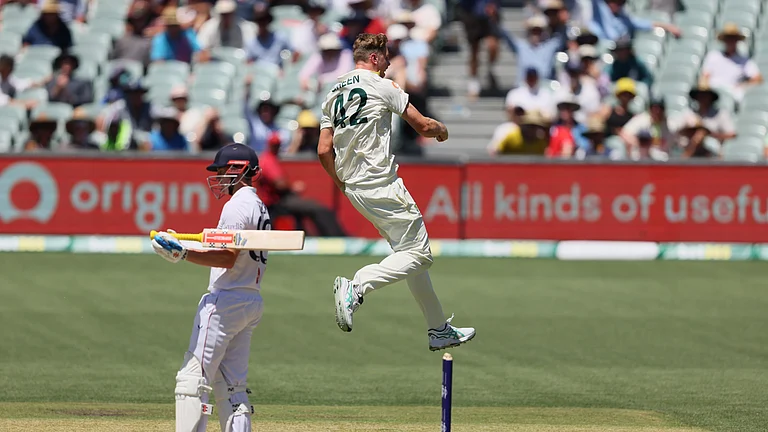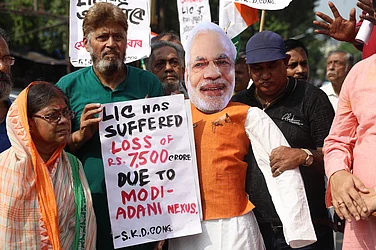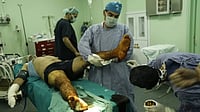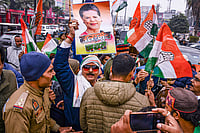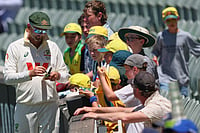In the one year since Jayalalitha’s reelection in May 2016, Tamil Nadu has seen three chief ministers—she, O. Panneerselvam (OPS) and E.K. Palaniswami (EPS). It even had a chief minister in waiting—V.K. Sasikala, Jayalalitha’s aide who became Chinnamma and then tried to become CM, only to end up in jail. Now the state is all set to have ‘half a chief minister’ in the form of T.T.V. Dinakaran.
The political churn witnessed by Tamil Nadu since Jayalalitha’s death in December 2016 has now thrown up a new political offering—a third faction of the AIADMK led by Dinakaran, deputy general secretary and Sasikala’s nephew. Dinakaran’s game plan to have his own set of loyalists as ministers has not found favour with chief minister EPS and the two are on an eyeball-to-eyeball confrontation. An unfazed Palaniswami has called a session of the Assembly on June 14, confident that no AIADMK MLA would dare to undermine his government as that might lead to a mid-term election that no one wants to face.
Dinakaran’s rise from near political anonymity during Jayalalitha’s last few years to virtual head of the ruling party is nothing but spectacular. Appointed as deputy general secretary before aunt Sasikala went to jail, Dinakaran’s job was to mind the newest proxy—EPS—so the government remained firmly in the control of the Mannargudi family. But Dinakaran wanted the throne to himself and chose to contest the RK Nagar bypoll, hoping to become MLA first and chief minister later.

Chief minister E.K. Palaniswami
But the Election Commission (EC) cancelled the poll as Dinakaran and his followers drenched the constituency with currency notes. A discredited Dinakaran had to spend 40 days in Tihar jail after being arrested by the Delhi Police for attempting to bribe an EC official to get back the AIADMK’s frozen ‘two leaves’ symbol. With the police unable to identify the intended bribe-taker—the EC official—Dinakaran was able to secure bail and return to Chennai.
In his absence, EPS had asserted himself, launched schemes and even publicised the achievements of his first 100 days in office. EPS also chose not to visit Sasikala in jail, had Dinakaran announce his own sanyas by getting his ministers to revolt against him and engaged the rival OPS faction for merger talks in the hope of sidelining the Sasikala family permanently. For a handpicked “proxy”, EPS proved craftier than anticipated as he gradually tightened his grip on the government and the party.
But Dinakaran showed he was made of sterner stuff as he hit back in a bid to reestablish his hold on the party. Back in Chennai, he gathered a horde of MLAs—26 at the last count—who claimed they belonged to his group. Most of them were ministerial aspirants, angry that EPS had not inducted them into the cabinet. “As days go by, the numbers will only increase and EPS will be forced to follow Dinakaran’s diktat,” says MLA P. Vetrivel, one of Dinakaran’s most vocal supporters. “We do not want to destabilise the government as this is Amma’s government. But it must have the unmistakable stamp of Dinakaran and Chinnamma.”
Dinakaran wants to take complete control of the party machinery and manage the government through remote control. “He realised his mistake of rushing in too fast to grab the chief minister’s post by contesting the RK Nagar bypoll,” points out a close aide. “It upset the Centre and also the Gounder community to which EPS belongs. The two collaborated to sideline him and even had the ministers speak against him.” A cornered Dinakaran voluntarily declared he would stay away from party affairs to facilitate the merger of the OPS and EPS factions and regain the ‘two leaves’ symbol. That was before he went to Tihar.
Once out, he declared he would play an active role in the party since the merger moves had failed to take off during his absence. While in jail, he had asked his two trusted MLAs Vetrivel and Thanga Thamizhselvan to organise party meetings in and around Madurai—the heart of the Thevar belt. Large crowds were mobilised to show that the cadres—especially among the Thevars (the community to which Sasikala and Dinakaran belong)—were fully behind Dinakaran, who was portrayed as a martyr who had gone to jail only to protect the party symbol.
As disgruntled former ministers and senior MLAs started demanding to be accommodated in the cabinet, Dinakaran’s men reached out and convinced them to rally behind him. “The CM was a spectator when the transport minister hijacked a new medical college from Karur. When he failed to resolve the matter, I turned to Dinakaran,” points out former transport minister Senthil Balaji. “As our numbers swell, EPS will have to listen to us.”
EPS, however, refused to surrender as OPS had done initially when Sasikala wanted the chair. Even as Dinakaran was meeting Sasikala at the Bangalore jail, the state’s ministers had an informal meeting and reiterated their earlier decision to unite the two factions by keeping the Sasikala family out. “You give them an inch, they will take the entire house,” says finance minister D. Jayakumar. “The moment our two factions announce the time-table for merger, all the MLAs with Dinakaran would come scurrying to us. No one wants an election now, definitely not the first-time MLAs.”
On the day some more MLAs trooped into Dinakaran’s residence, EPS had his photograph displayed in every minister’s room, along with those of MGR and Jayalalitha—as if to show who the master was. His trusted duo—ministers S.P. Velumani and P. Thangamani—reopened the stalled merger talks with the OPS faction. According to one proposed solution, OPS would become general secretary and, midway through the five-year term, could return as chief minister and a probe into Jayalalitha’s death would be ordered. In response, Panneerselvam readily held out the olive branch, saying, “Our group will not do anything to bring down the Palaniswami government.” Incidentally, only OPS and his MLAs had voted against the EPS government in February after the Opposition had vacated the house.
Since another confidence vote is not possible until July end, the ruling faction has enough time to set its house in order. But for a constitutional bar on the number of ministers a government can have, EPS would perhaps have happily appointed all the MLAs as ministers to buy permanent peace. Something Cho Ramaswamy had done in his Tamil satire Muhammed Bin Thuglak, who as prime minister appoints all the MPs as deputy prime ministers to quell the demand for ministries.
***
The Presidential Question
The sudden infighting in the AIADMK has unnerved the BJP as it was counting on all the 134 MLAs (122 of EPS and 12 of OPS) plus all their MPs (37 LS and 11 RS) to vote for its candidate, giving it a comfortable margin of victory. With nearly 30 MLAs and a dozen MPs tagging behind Dinakaran, their stand during the presidential poll remains uncertain as of now.
If the recent articles in the party’s official organ Namadhu MGR, which is controlled by Dinakaran and his wife Anuradha, are any indication, they point to a total dissatisfaction with the Modi dispensation. The daily had published a hard-hitting critique of three years of the Modi government, calling it “a mere ornament of words and no action”. Dinakaran had also frowned upon OPS and EPS competing with one another to meet Modi in Delhi—each trying to be more loyal than the other.
“We have over a month to set our house in order,” says a senior minister. “Since the DMK is with the Opposition, no faction of the AIADMK can afford to be seen voting on their side. At best, Dinakaran’s MLAs and MPs may abstain, which would be to the BJP’s advantage.”
By G.C. Shekhar in Chennai










